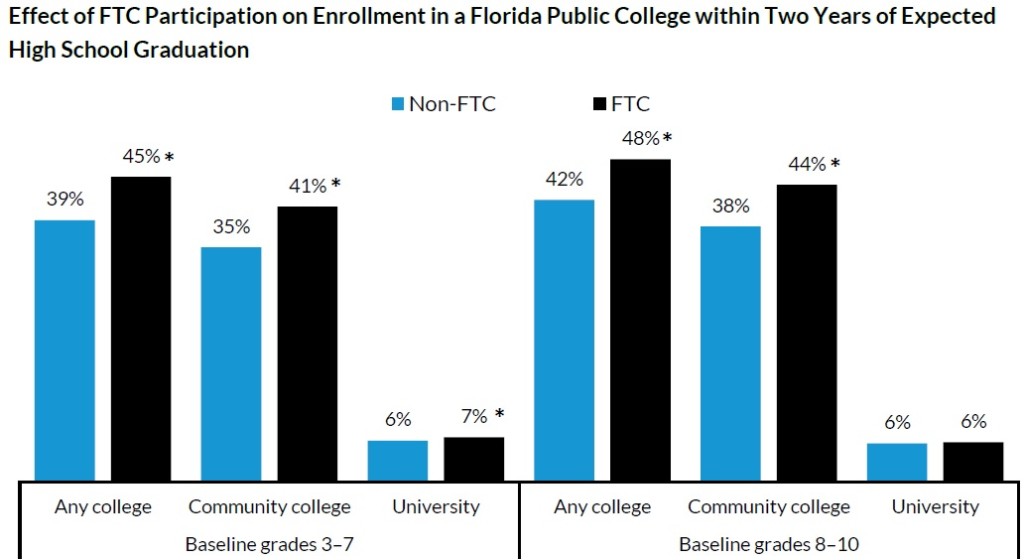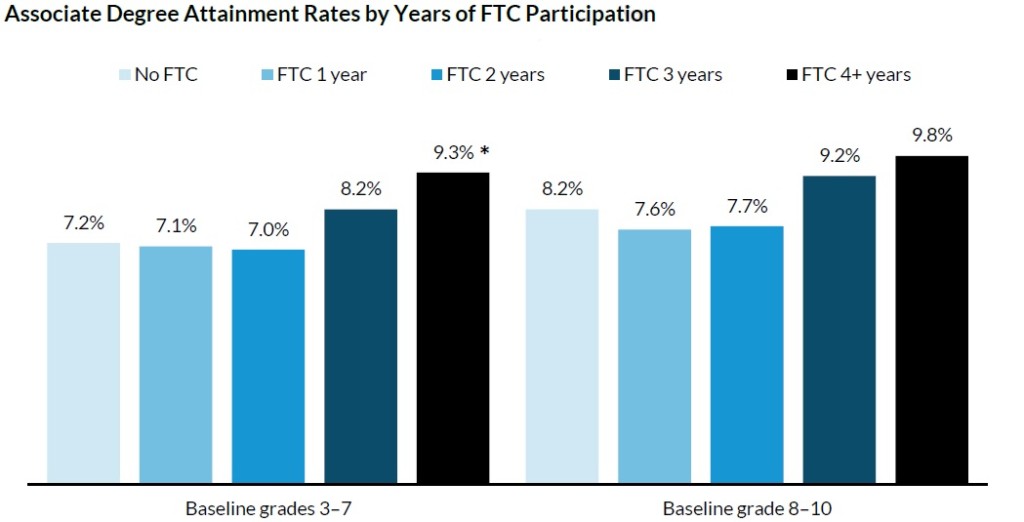The “triply disadvantaged” students who participate in the nation’s largest private school choice program enroll in college and obtain degrees at higher rates than like students in public schools, and those rates climb the longer the students use the scholarship, according to a first-of-its-kind study released this morning by The Urban Institute.
The college enrollment rate overall is 15 percent higher for the low-income students who use Florida tax credit scholarships, the study found. That climbs to about 40 percent higher for students who use a scholarship at least four years.
The longer students participate in the Florida tax credit scholarship program, the more likely they are to enroll in college, compared to peers who do not receive scholarships. Chart by Step Up For Students, using data from the Urban Institute.
Meanwhile, scholarship students are 8 percent more likely to obtain associate degrees. That number rises to 29 percent for those who secured scholarships in earlier grades and used them at least four years.
Annual evaluations of standardized test results in the scholarship program have consistently found the average student who uses the program to attend a private school makes roughly one year’s academic progress in one year’s time.
[cp_modal display=”inline” id=”cp_id_bceb2″][/cp_modal]
They’ve also found students who use the scholarships tend to be more disadvantaged than other lower-income students who don’t use them.
Urban Institute authors Matthew M. Chingos and Daniel Kuehn describe scholarship students this way: “They have low family incomes, they are enrolled at low-performing public schools (as measured by test scores), and they have poorer initial test performance compared with their peers.”
Studies have looked at long-term outcomes for other programs that help disadvantaged students pay private school tuition.
They found students in Washington, D.C. and Milwaukee were more likely to graduate high school or attend college, respectively, if they received a voucher.
But researchers haven’t looked as much at college enrollment among students who received scholarships from big, statewide programs. The Urban Institute report is unprecedented in its scale. It looks at more than 10,000 students across the nation’s third-largest state. It uses data from the Florida Department of Education, as well as Step Up For Students, the nonprofit that helps administer the scholarships.
Unpacking the findings
The study finds students who use tax credit scholarships are significantly more likely than peers with similar disadvantages to enroll in college within two years of finishing high school.
Students who use Florida tax credit scholarships are more likely to enroll in college. Chart by Urban Institute. *Means results are statistically significant.
Students who continued using a scholarship for four years or more saw, by far, the largest college-enrollment boost. Those who only used a scholarship for one year saw essentially no benefit.
The researchers note one potential factor. Students who leave the scholarship program after a short time tend to struggle more academically. Those who remain on scholarships for several years tend to perform better, perhaps because they’ve found schools that work for them.
Most of the enrollment boost for scholarship alumni happened at Florida’s community colleges. The state’s 28 community colleges are intended to be accessible and affordable. Tuition and fees for full-time Florida College System students working toward associate degrees cost roughly half what students pay at the state’s four-year public universities. The researchers noted the two-year schools are “more financially accessible to the low-income students participating in FTC.”
The researchers didn’t look at private or out-of-state institutions, where data wasn’t as readily available. As a result, they cautioned that: “National data indicate that low-income students from private high schools are more likely to enroll in private and out-of-state colleges than low-income students from public high schools. Because of this, our results may understate the true impact of FTC participation on college enrollment and degree attainment.”
The enrollment boost was larger for a few notable groups. Scholarships students born outside the U.S. and those who spoke a language other than English at home saw some of the largest jumps in college enrollment.
Scholarship students weren’t just more likely to attend two-year colleges. They were also 8 percent more likely to earn associate degrees. But the researchers note there was some drop-off between the jump in college attendance and the jump in completion.
Students who use Florida tax credit scholarships are more likely to obtain associate degrees. Chart by Urban Institute. *Means results are statistically significant.
Also, scholarship students were not significantly more likely to earn four-year degrees. The researchers note their sample sizes were small for this group, so it was hard to make statistical comparisons. They also noted that only 4 percent of the disadvantaged public-school students they compared to scholarship recipients earn bachelor’s degrees.
What the findings mean
Low-income students from high-poverty schools face greater barriers getting to college than their middle-income peers. To earn a four-year degree, the barriers are larger still. They’re more likely to struggle with tuition payments, student loans and jobs that take time away from their studies.
These barriers deserve a closer look, the Urban Institute researchers write.
This study finds that the nation’s largest private school choice program helps students into college, but too many still fail to earn degrees. A fuller understanding of what this means for these students will require continuing to track their outcomes, including bachelor’s degree attainment rates and incomes. But this study shows that policymakers considering the design, expansion, or reform of private school choice programs should carefully consider not just their likely impact on short-term metrics such as test scores, but also how they might shape long-term outcomes, including college enrollment and graduation.
Other programs dedicated to expanding educational opportunity for lower-income students have seen similar results. In 2011, the Knowledge Is Power Program learned roughly 33 percent of students who completed middle school with the nation’s largest charter school network managed to graduate college.
Those results didn’t satisfy KIPP. So the charter organization created a new program to help its alumni not only reach college, but finish it.
Still, for school choice programs facing a flurry of headlines, the Urban Institute report suggests the anecdotes about school choice scholarship recipients awakening to the possibility of college aren’t mere anomalies.




